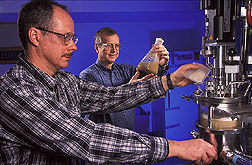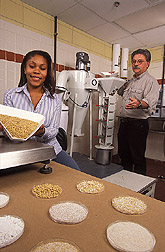New Varieties and Techniques
Make Barley Better For Fuel and Food
|
|
New varieties of barley could help solve two national problems: energy dependence and obesity. That’s because some parts of barley are excellent for making fuel ethanol, while other parts are nutritious and naturally low in calories.
High starch content is needed to produce ethanol, while soluble fibers such as beta-glucan and other types of fiber have been found to possess health benefits for people. Now scientists are developing ways to maximize the benefits found in some special barley varieties.
Researchers at the Eastern Regional Research Center (ERRC) in Wyndmoor, Pennsylvania, want to reduce the cost of fuel ethanol and make it available nationwide. Most ethanol production facilities use corn as starting material, or “feedstock,” and not surprisingly, they’re located in the Corn Belt, not on the East and West Coasts, where demand for fuel ethanol is increasing. It’s too costly for most coastal states to ship corn from the Midwest to a local ethanol plant, so it makes sense for these “corn-deficient” states to use locally grown grains as alternatives. Barley, which grows well in these regions, may be the answer—once a couple of problems are solved.
“Barley isn’t usually thought of as a good candidate for fuel ethanol feedstock because it typically has an abrasive hull and a lower starch content than corn,” says Kevin Hicks, research leader of ERRC’s Crop Conversion Science and Engineering Research Unit. “And it contains a troublesome polysaccharide, beta-glucan, that makes barley mash too viscous to mix, ferment, and distill economically.”
Low starch content in most barley varieties—50 to 55 percent compared to corn’s 72 percent—results in lower ethanol yield. ARS researchers are helping to create new barley varieties with higher starch content. They’re also developing new milling processes that will separate low-starch barley kernels into a starch-enriched stream for efficient ethanol production and a protein- and fiber-enriched fraction for making valuable food and feed co-products.
Research is needed to help growers select the best varieties for ethanol production and to solve technical problems related to milling and fermenting barley. ARS also wants to expand the feed applications for barley distillers dried grains with solubles (DDGS), the main co-product from “dry grind” ethanol production
In the process of finding solutions to all these needs, ARS researchers may have also found some ways to provide the food industry with nutritious ingredients.
Better Varieties for Ethanol Production
|
|
ERRC researchers examined more than 100 new lines of barley being developed by collaborators at Virginia Polytechnic Institute and State University for suitability in ethanol production and have narrowed their focus to several promising varieties. Lines being developed at the ARS Small Grains and Potato Germplasm Research Unit in Aberdeen, Idaho, are also being evaluated.
The scientists are looking at malt, hulled, and hull-less barley varieties suitable for growers in various parts of the country.
Most barley not selected for brewing is used in animal feed and sells for well under $2 a bushel, according to Hicks. Producers would like to see a higher return for their crop.
Barley hulls are very abrasive and cause expensive wear and tear on grain handling and milling equipment. Removing the hull and other nonstarch components of the kernel before fermentation for ethanol would greatly improve the production process. A combination of milling, grinding, and size-fractionation techniques could accomplish this. But perhaps an even better idea is to use barley varieties that are naturally hull-less, avoiding the need for “pearling”—a process that removes the hull and makes the grains smaller and rounder. As Rolando Flores, an ERRC agricultural engineer, explains, pearling removes the hull, divides the fiber into several fractions, and separates the protein from the starch to produce ethanol without wasting low-starch barley co-products.
Hull-less varieties lose their hull during harvesting. They have more starch and protein but less fiber than hulled varieties. Several Virginia hull-less lines look promising in ERRC’s program.
Hull-less barley solves the “hull” problem but not the beta-glucan viscosity issue. With hulled varieties, fractional milling techniques such as pearling help by removing beta-glucan-enriched fractions before fermentation. But these techniques don’t remove all the beta-glucan. So, for both hull-less and hulled varieties, beta-glucanase enzymes are used in fermentation to dramatically break down high-viscosity beta-glucans into low-viscosity oligosaccharides, solving the beta-glucan problem, according to Dennis O’Brien, an ERRC chemical engineer.
Nutrition for Feed and Food
Animal feeds rich in beta-glucan cause nutritional problems in poultry. Beta-glucan in DDGS limits their application for use as feed mainly to ruminants, such as cattle. But high-protein DDGS fractions with low-levels of beta-glucan would make useful ingredients in poultry, swine, and fish feeds. The ERRC team is making progress in this area.
Barley fractions that are high in beta-glucan might also find use in certain foods. Beta-glucan has been found to lower cholesterol levels and blood pressure and improve immune function in human studies.
Scientists with the Beltsville (Maryland) Human Nutrition Research Center’s (BHNRC) Diet and Human Performance Laboratory will study the possibility of using beta-glucan and other soluble fibers not being used in ethanol production. Future studies at BHNRC will include human feeding studies designed to test the health-promoting effects from foods prepared with the ERRC barley co-products.
“In our previous human feeding studies, consumption of soluble fiber from barley significantly improved several risk factors for cardiovascular disease and diabetes,” says Kay Behall, a BHNRC chemist.
Robert A. Moreau, an ERRC chemist on the project, says fractions remaining after milling are also low in starch, so they’re low in carbohydrates and high in dietary fiber, oil, and protein, which makes them ideal nutraceuticals—ingredients added to food for their health benefits. Barley fractions could be added to pasta, breads, pastries, and snack foods to increase their fiber content and reduce starch.
Moreau and cooperators at the University of Helsinki in Finland found that phytosterols in grains such as barley and rye are concentrated in the outer layers, or “fines,” of kernels. Some studies have found that these plant sterols might contribute to a reduced risk of coronary heart disease. Currently, sterols are used to enrich products such as margarine and orange juice.
ARS researchers are using pearling to remove plant sterols and fiber-enriched outer layers of hull-less barley. “We found that fines removed from kernels contained two to three times as many phytosterols per unit weight as did whole kernels. These fines could serve as a new source of phytosterols,” Moreau says.—By Jim Core, Agricultural Research Service Information Staff.
This research is part of Quality and Utilization of Agricultural Products (#306) and Bioenergy and Energy Alternatives (#307), two ARS National Programs described on the World Wide Web at http://www.ars.usda.gov/research/programs.htm.
Kevin Hicks is in the USDA-ARS Crop Conversion Science and Engineering Research Unit, Eastern Regional Research Center, 600 East Mermaid Ln., Wyndmoor, PA 19038-8598; phone (215) 233-6579, fax (215) 233-6406.
"New Varieties and Techniques Make Barley Better For Fuel and Food" was published in the July 2005 issue of Agricultural Research magazine.









